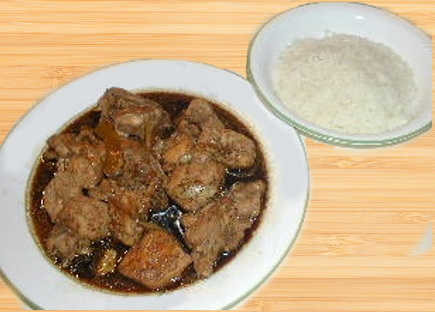
The most famous of all Philippine dishes is adobo. Delicious and easy to make. Here is a recipe for chicken adobo and a recipe for the sweet snack known as turon.
Anyone who visits a Filipino home is offered food by the question, Kumain ka na?, which means "Have you eaten?" It is a polite gesture to say that you haven't eaten even though you may already have. During the preparation of meals, it is also considered polite to ask the host if he or she needs assistance. Most likely, however such an offer to help will be politely refused by the host.
Much of the Philippine population are Catholics or Christians. This is particular true of the lowland ares, in the cities and in the northern part of the country. Christians in the Philippines typically pray before meals to express their thanks and ask for blessings. Eating is normally a social affair enjoyed with friends and family. Sharing food is very common amoung Filipinos who eat together. Filipinos often eat with their hands, which is called kamayan. However, forks and spoons are increasingly popular and preferred by some eaters. Filipino dishes are usually served buffet style with all the dishes presented at the same time. Burping after a meal is not considered rude, instead it is interpreted as an expression of satisfaction. When a party or gathering comes to an end it is common for guests to be offered food to thank them for coming to the festivities. If you attend a a Filipino gathering most likely will leave with plates full of wonderful Filipino dishes
Like other countries, the Philippines have several dishes that are considered to be representative of the country's cuisine. Favorite Filipino dishes include adobo, kare-kare, sinigang, and lumpia. There are many Filipino stores that serve these and many other wonderful Filipino foods in San Diego. Popular Filipino restaurants are Point-Point, Conchings, and Tita's Kitchenette, which are all located in National City.
Below are recipes for two well-known easy to prepare Filipino Dishes. So, as we say in Tagalog, Filipino national language, Pagsaluhan natin or let's dig in!
Adobo is one of the many national dishes in the Philippines. It is a Spanish-influenced Filipino dish that is believed to have originated from Pampanga, a northern part of the Philippines. Adobo is made usually from chicken or pork. The meat is first marinated with a variety of seasonings and flavorings including soy sauce, crushed garlic, and vinegar and then slow-cooked. Adobo has many ingredient variations and methods of preparation. Other countries, including Mexico and the Caribbean, also produce their own tasty versions of adobo. The blending of sweet, sour, and spicy flavors will leave your taste buds delighted. Adobo is a simple to prepare meal that does not take much time or many ingredients.
Chicken Adobo Ingredients:
- 1 whole chicken cut into pieces as in photo
- ¼ cup vinegar
- ½ cup soy sauce
- 5 crushed cloves of garlic
- ¾ cup water
- 1 bay leaf
- 1 teaspoon ground pepper
Chicken Adobo Preparation:
- Cut a whole chicken into small bite-size pieces.
- Place the chicken in a 2 quart pot.
- Add vinegar, soy sauce, crushed garlic, bay leaf, pepper, and water to the pot.
- Bring the liquid to a boil while stirring. Lower the heat to a gentle boil.
- Cover the pot and simmer for about 25 to 30 minutes. Stir occasionally.
Then, yan, tapos na (It's done)! It is simple as that.
Adobo is usually served with white rice so it is be a great idea to start the rice cooking while you are letting the chicken simmer.
Turon
Turon is a wonderful Filipino tasty sweet snack to enjoy anytime of the day. It is a fried combination of banana and jackfruit laced with brown sugar. Turon is often made for Filipino get togethers and parties.
Turon Ingredients:
- 3 tablespoons of brown sugar
- 1 package of lumpia wrapper
- Canaola oil or vegetable oil
- Bananas (saba are the best)
- Ripe Jackfruit (optional, it is very sweet)
Turon Preparation:
Saba bananas are usually used for Turon. You can find saba bananas in most Asian grocery stores. For this recipe, we used regular bananas.
- Begin by cutting the bananas in half.
- Then, cut the half of both bananas length-wise so that you have four pieces of banana.
- Roll the pieces of banana in the brown sugar until they are completely coated.
- Wrap each sugar-coated banana piece in its own separate lumpia wrapping paper. (Don't worry, lumpia wrappers usually come with instructions)
- Pour an inch of oil into a frying pan and turn the heat to medium (350 degrees).
- Carefully place the wrapped turons into the frying pan using a pair of tongs.
- Fry the turons until the bottom of the turon turns golden brown then flip the turon over and cook the other side.
- After the turons turn a wonderful golden brown, remove and let them cool a bit. It doesn't take long for lumpia wrappers to brown so monitor the frying closely.
Recipes and Photos by Nuelma Patio









